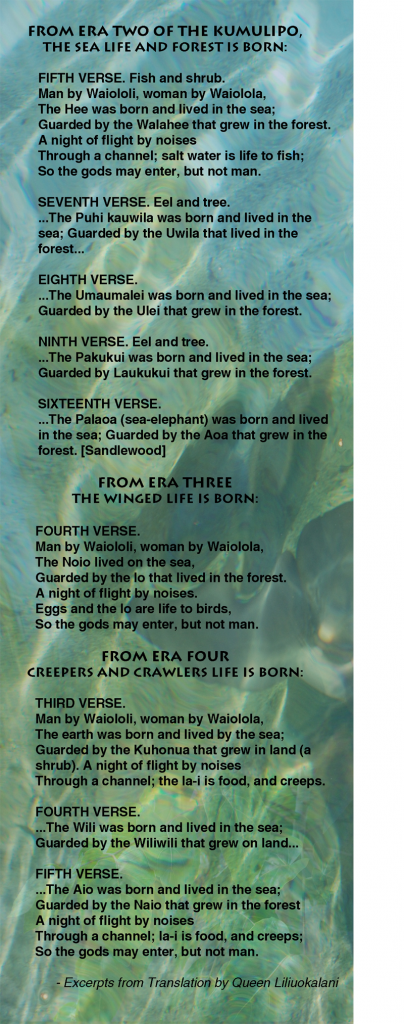Cultural Ecology was defined by anthropologist Charles O. Frake in 1962 as the “study of the role of culture as a dynamic component of any ecosystem”. It explains that humans are part of their environment and both affects each other; that there is a relationship of interconnectedness between living things, the land, air and waters. Hawaiian culture, like many indigenous cultures, view this interconnectedness as a continuum that draws upon the past, with a commitment to the future. Hawaiians believe the privilege of this relationship with the land that sustains life, carries with it a kuleana or responsibility.
At its core is the guiding principal—take care of the land and the land will take care of you.

Photo of Ka`ūpūlehu makai. Courtesy of Kona Historical Society.
The modern concept of “conservation” is not new at all. Many indigenous cultures have ancient codes of conduct to manage people, their movement upon the land, spiritual well-being and to care for resources. The Hawaiian “kapu system” that is no longer in place, was one such system, as well as caring for the land based on the “ahupua’a system“. Known for their keen observation (kilo) of nature, Hawaiians accumulated vast knowledge (‘ike) of the natural world, and this ‘ike was passed down by elders to the next generation. The last 200 years has brought vast changes to the lands and society of Hawai`i. These sweeping changes have brought severe ecological problems that need new solutions. But it also requires drawing upon history, wisdom of elders and “indigenous knowledge” that is carried through families and cultural disciplines based upon centuries of observation, oral tradition, intimacy and refining.
The following video from the 2018 Dryland Forest Symposium speaks to the cultural reasons for restoring dry forests:
Nāhelehele advocates for a balanced partnership and relationship between cultural ecology, science, education and community. The loss of native ecosystems and compromised environments is staggering and economic resources for this task are few. Working together in creative, respectful partnerships in the spirit of kuleana for the land is our hope for the future.
The resources below provide further insight to Hawaiian Cultural Ecology and expresses a deep abiding love for the land, winds and waters:
MĀLAMA PONO I KA ‘ĀINA–AN OVERVIEW OF THE HAWAIIAN CULTURAL LANDSCAPE by Kepa Maly. See his website for more about the work of Kumu Pono Associates.
NĀ HONUA MAULI OLA–Hawai‘i Guidelines for Culturally Healthy and Responsive Learning Environments (NHMO) are now available for downloading by going to their site. These guidelines have been developed by the Native Hawaiian Education Council (NHEC) in partnership with Ka Haka ‘Ula O Ke‘elik_lani College of Hawaiian Language. The document includes a set of sixteen guidelines that contain strategies and recommendations for improving the quality of educational outcomes for learners, educators, families, communities and schools/institutions.
“GUIDANCE IN AN ERA OF TRANSFORMED LANDSCAPES” is a video of a talk by Sam ‘Ohu Gon at the 2011 Dryland Symposium and gives an overview of the cultural and botanical diversity of dry forest ecosystems.
ULUKAU—THE HAWAIIAN ELECTRONIC LIBRARY is a wealth of information about language, mo`olelo, and things Hawaiian. See books, music, Hawaiian newspapers and other resources at this website. They also host electronic versions of Hawaiian dictionaries and Hawaiian placenames.
“NAVIGATING CHANGE” is a project focused on raising awareness and motivating people to better care for our islands and our ocean resources. The project is an educational partnership that includes private organizations, state agencies and federal agencies that share a collective vision for creating a healthier future for Hawai`i and for our planet.
SCIENCE IN HAWAI`I: NA HANA MA KA AHUPUA`A: A Culturally Responsive Curriculum Project. Provides downloadable lesson plans and resources.
GATHERING PAMPHLET is about thoughtful, responsible cultural gathering and use. “This pamphlet is the result of bringing together the knowledge of kupuna and ecological studies.” By Namaka Whitehead, Ho`ola Frai`ola, and Tamara Ticktin.
INDIGENOUS SCIENCE is a scholarly paper about the importance of respecting and drawing upon indigenous knowledge and science for time tested understandings; and its implications for science education. By Gloria Snively, and John Corsiglia.
LIVING KNOWLEDGE—INDIGENOUS SCIENCE IN EDUCATION website is part of a three year Australian Research Council (ARC) research project Indigenous knowledge and Western science pedagogy: a comparative approach. The project aims to determine the most effective ways of incorporating Indigenous knowledge within the NSW secondary school science curricula. Portions of this website and thought might provide ideas for your own explorations integrating both systems into land and sea management and education. See their other Indigenous Science resources and how to incorporate indigenous science into your teaching and curriculum.
CONCEPT OF REALMS—WAO LANI, WAO AKUA is a video introduction by Dr. Sam Gon III on a website by Bishop Museum “Bringing Hawaiian Culture To Life”.

